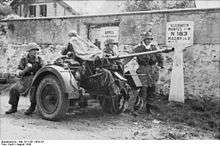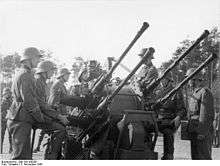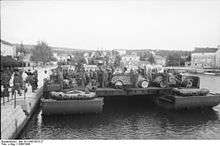2 cm Flak 30/38/Flakvierling
| 2 cm Flak 30 | |
|---|---|
 A 2 cm Flak 30 and its crew in Seine-et-Oise, France, August 1944 | |
| Type | Anti-aircraft cannon |
| Place of origin | Nazi Germany |
| Service history | |
| In service | April 1934–45 |
| Used by |
Nazi Germany Finland |
| Wars | World War II |
| Production history | |
| Manufacturer |
Rheinmetall-Borsig Mauser |
| Produced | 1934–45 |
| No. built |
more than 144,000[1] (Flakvierling count per barrel) |
| Variants | 2 cm Flak 38, Gebirgsflak 38, Flakvierling 38 |
| Specifications | |
| Weight | 450 kg (992 lbs) |
| Length | 4.08 m (13 ft 5 in) |
| Barrel length | 1.3 m (4 ft 3 in) L/65 |
| Width | 1.81 m (5 ft 11 in) |
| Height | 1.6 m (5 ft 3 in) |
| Crew | 5 |
|
| |
| Shell | 20×138mmB |
| Caliber | 20 mm (.79 in) |
| Elevation | -12°to ±90° |
| Traverse | 360° |
| Rate of fire |
280–450 rpm (cyclic) 120–180 rpm (practical) |
| Muzzle velocity | 900 m/s (2,953 ft/s) |
| Effective firing range | 2,200 m (2,406 yds) (anti-aircraft) |
| Maximum firing range | 5,783 m (5,230 yds) (ground range) |
| Feed system | 20 round box magazine |
The Flak 30 (Flugabwehrkanone 30) and improved Flak 38 were 20 mm anti-aircraft guns used by various German forces throughout World War II. It was not only the primary German light anti-aircraft gun, but by far the most numerously produced German artillery piece throughout the war.[1] It was produced in a variety of models, notably the Flakvierling 38 which combined four Flak 38 autocannons onto a single carriage.
Development

The Germans fielded the unrelated early 2 cm Flak 28 just after World War I, but the Treaty of Versailles outlawed these weapons and they were sold to Switzerland.
The original Flak 30 design was developed from the Solothurn ST-5 as a project for the Kriegsmarine, which produced the 20 mm C/30. The gun fired the "Long Solothurn", a 20 × 138 mm belted cartridge that had been developed for the ST-5 and was one of the most powerful 20 mm rounds in existence.[2]
The C/30, featuring a barrel length of 65 calibres, had a rate of about 120 rounds per minute. Disappointingly, it proved to have feeding problems and would often jam, which was offset to some degree by its undersized 20 round-magazine which tended to make reloading a frequent necessity. Nevertheless, the C/30 became the primary shipborne light AA weapon and equipped a large variety of German ships. The MG C/30L variant was also used experimentally as an aircraft weapon, notably on the Heinkel He 112, where its high power allowed it to penetrate armored cars and the light tanks of the era during the Spanish Civil War.
Rheinmetall then started an adaptation of the C/30 for Army use, producing the 2 cm Flak 30. Generally similar to the C/30, the main areas of development were the mount, which was fairly compact. Set-up could be accomplished by dropping the gun to the ground off its two-wheeled carriage and levelling with hand cranks. The result was a triangular base that allowed fire in all directions.
But the main problem with the design remained unsolved. The rate of fire of 120 RPM (rounds per minute) was not particularly fast for a weapon of this calibre. Rheinmetall[N 1] responded with the 2 cm Flak 38, which was otherwise similar but increased the rate of fire to 220 RPM and slightly lowered overall weight to 420 kg. The Flak 38 was accepted as the standard Army gun in 1939, and by the Kriegsmarine as the C/38.
In order to provide airborne and mountain troops with AA capabilities, Mauser was contracted to produce a lighter version of the Flak 38, which they introduced as the 2 cm Gebirgsflak 38 (2 cm GebFlak 38). It featured a dramatically simplified mount using a tripod that raised the entire gun off the ground, which had the side benefit of allowing it to be set up on an uneven surface. These changes reduced the overall weight of the gun to a mere 276.0 kg. Production started in 1941 and entered service in 1942.
Ammunition
A wide variety of 20x138B ammunition was manufactured to be used in 2 cm Flak weapons; some of the more commonly used types are listed on the following table.[3] Other kinds than in existence included numerous practice rounds (marked Übung or Üb. in German notation) and a number of different AP types. A high-velocity PzGr 40 round with a tungsten carbide core in an aluminium body existed in 20x138B caliber.
| German designation | US Abbreviation | Projectile weight [g] | Bursting charge | Muzzle velocity [m/s] | Description |
|---|---|---|---|---|---|
| Sprenggranatpatrone L'spur mit Zerleger | HE-T | 115 | 6.0 g HE (PETN) | ? | Nose fuzed tracer round, self-destruct at 5.5 seconds (2000m range) due to tracer burn-through. |
| Sprenggranatpatrone L'spur mit Zerleger | HE-T | 120 | 6.6 g HE (PETN) | ? | Boat-tailed HE tracer round with nose fuze. Self-destruct at ca.2 km range due to tracer burn-through. |
| Brandsprenggranatpatrone L'spur mit Zerleger | HEI-T | 120 | 2.4 g HE (RDX+wax) + 4.1 g incendiary (zinc) |
900 m/s | Nose fuze, tracer (5 second burn), with self-destruct |
| Brandsprenggranatpatrone mit Zerleger | HEI | 120 | 22 g total (HE and incendiary) | ? | Nose fuze, no tracer, with self-destruct. Lack of tracer and high density of incendiary allows heavy filling load. |
| Panzergranatpatrone L'spur mit Zerleger | APHE-T | 146 | ? | ? | Base-fuzed tracer round, with self-destruct due to tracer burn-through after 2 second flight (1000m range). |
| Panzerbrandgranatpatrone (Phosphor) L'spur ohne Zerleger | API-T | 148 | 3.0 g incendiary (WP) | 800 m/s | Tracer round, with no fuze or self-destruct function. |
| Panzersprenggranatpatrone L'spur mit Zerleger (Kriegsmarine) | APHE-T | 121 | 3.6 g HE | ? | Base-fuzed round, self-destruct after 4.5 second flight (1800m range) due to tracer burn-through. |
2 cm Flakvierling 38
| 2 cm Flakvierling 38 | |
|---|---|
 Members of the Panzer-Grenadier-Division Großdeutschland train with a 2 cm Flakvierling 38 (1943) | |
| Type | Anti-Aircraft Gun |
| Place of origin | Nazi Germany |
| Service history | |
| In service | March 1940–1945 |
| Used by | Nazi Germany |
| Wars | World War II |
| Production history | |
| Designed | 1940 |
| Manufacturer | Mauser |
| Produced | 1940–1945 |
| Specifications | |
| Weight | 1,509 kg (3,327 lbs) |
| Length | 4.08 m (13 ft 5 in) |
| Barrel length | 1.3 m (4 ft 3 in) L/65 |
| Width | 1.81 m (5 ft 11 in) |
| Height | 1.6 m (5 ft 3 in) |
| Crew | 8 |
|
| |
| Shell | 20×138mmB |
| Caliber | 20 mm (.78 in) |
| Elevation | - 10° - +100° |
| Traverse | 360° |
| Rate of fire |
1,800 rpm (Cyclic) 800 rpm (Practical) |
| Muzzle velocity | 900 m/s (2,953 ft/s) |
| Effective firing range | 2,200 m (2,406 yds) (anti-aircraft) |
| Maximum firing range | 5,783 m (5,230 yds) (ground range) |
| Feed system | 4x 20 round box magazines |
Even as the Flak 30 was entering service, the Luftwaffe and Heer (army) branches of the Wehrmacht had doubts about its effectiveness, given the ever-increasing speeds of low-altitude fighter-bombers and attack aircraft. The Army in particular felt the proper solution was the introduction of the 37 mm caliber weapons they had been developing since the 1920s, which had a rate of fire about the same as the Flak 38, but fired a round with almost eight times the weight. This not only made the rounds deadlier on impact, but their higher energy and ballistic coefficient allowed them to travel to much longer distances, allowing the gun to engage targets at longer ranges. This meant it could keep enemy aircraft under fire over longer time spans.
The 20 mm weapons had always had weak development perspectives, often being reconfigured or redesigned just enough to allow the weapons to find use. Indeed, it came as a surprise when Rheinmetall introduced the 2 cm Flakvierling 38, which improved the weapon just enough to make it competitive once again. The term Vierling literally translates to "quadruplet" and refers to the four 20 mm gun constituting the design.
The Flakvierling weapon consisted of quad-mounted 2 cm Flak 38 AA guns with collapsing seats, folding handles, and ammunition racks. The mount had a triangular base with a jack at each leg for levelling the gun. The tracker traversed and elevated the mount manually using two handwheels. When raised, the weapon measured 307 cm (10 feet 1 inch) high.
Each of the four mounted guns had a separate magazine that held only 20 rounds. This meant that a maximum combined rate of fire of 1,400 rounds per minute was reduced practically to 800 rounds per minute for combat use – which would still require that a magazine to be replaced every six seconds, on each of the four guns.
The gun was fired by a set of two pedals — each of which fired two diametrically opposite barrels — in either semi-automatic or fully automatic mode. The effective vertical range was 2,200 metres. It was also used just as effectively against ground targets as it was against low-flying aircraft.[4]
Mounting versatility

The Flakvierling four-autocannon anti-aircraft ordnance system, when not mounted into any self-propelled mount, was normally transported on a Sd. Ah. 52 trailer, and could be towed behind a variety of half-tracks or trucks, such as the Opel Blitz, SdKfz 251 and SdKfz 11. Its versatility concerning the vehicles it could be mounted to included its common use on half-tracks and tank hulls to produce mobile anti-aircraft vehicles, such as the SdKfz 7/1 (based on the SdKfz 7 half-track) and the Wirbelwind and original Möbelwagen prototype (both based on the Panzer IV tank). In Kriegsmarine use, it was fitted to U-boats, Siebel ferries and ships to provide short-range anti-aircraft defence, and was also employed in fixed installations around ports, harbours and other strategic naval targets. The Flakvierling was also a common fixture on trains, even on Hitler's own command train, where pairs of them were mounted on either end of a "camelback" flatbed car and then covered to make it look like a boxcar, sometimes with a pair of such twin-Flakvierling mount cars for defense, one near each end of Hitler's Führersonderzug train.
Users
.svg.png) Germany
Germany Lithuania 150 Flak 30 (20 mm lėktuvinis automatinis pabūklas LAP) bought in 1939.
Lithuania 150 Flak 30 (20 mm lėktuvinis automatinis pabūklas LAP) bought in 1939. Finland 50 Flak 30 (named 20 Itk/30 BSW) delivered from Germany in 1939. 113 Flak 38 (named 20 ItK/38 BSW) guns bought during Continuation War.
Finland 50 Flak 30 (named 20 Itk/30 BSW) delivered from Germany in 1939. 113 Flak 38 (named 20 ItK/38 BSW) guns bought during Continuation War. Greece 108 total in service
Greece 108 total in service Romania unknown number, known as Gustloff guns (after one of their manufacturers)
Romania unknown number, known as Gustloff guns (after one of their manufacturers)
See also
- List of anti-aircraft guns
- List of artillery of Germany
- MG 151 cannon
- MG FF cannon
- 2 cm KwK 30 - variant for armored cars and light tanks, slightly shortened barrel
Similar
- M45 Quadmount, the closest Allied equivalent to the Flakvierling system
Notes
References
- 1 2 "German Weapon and Ammunition Production". Archived from the original on 14 June 2011. Retrieved 30 July 2011.
- ↑ An introduction to collecting 20 mm cannon cartridges
- ↑ 20mm Suomessa - Aseet ja ampumatarvikkeet (20mm in Finland - Weapons and Ammunition). Pitkänen S., Simpanen T, 2007. ISBN 978-952-5026-59-7.
- ↑ The Encyclopedia of Weapons of World War 2
Bibliography
- Gander, Terry and Chamberlain, Peter. Weapons of the Third Reich: An Encyclopedic Survey of All Small Arms, Artillery and Special Weapons of the German Land Forces 1939-1945. New York: Doubleday, 1979 ISBN 0-385-15090-3
- Hogg, Ian V. German Artillery of World War Two. 2nd corrected edition. Mechanicsville, PA: Stackpole Books, 1997 ISBN 1-85367-480-X
External links
| Wikimedia Commons has media related to 2 cm FlaK 30/38/Flakvierling. |
- tarrif.net (dead link)
- 2 cm Flak 38: A.A./A.T. Gun, Catalog of Enemy Ordnance, U.S. Office of Chief of Ordnance, 1945.